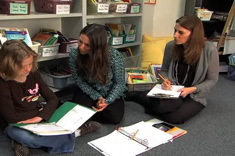One of the teachers in a class I was facilitating recently made this comment about writing and thinking. She said, “I know how we do metacognition in reading because reading is internal, and I know how we do metacognition in math because we have to make our thinking visible, but writing is external. Everything a writer thinks is on the page.”
A couple of her colleagues nodded. I didn’t know what to say. Being “one who writes” as soon as I could hold a pencil, I’ve always been very aware of my thinking about writing; there are volumes that don’t go on the page.
Lately I’ve been heeding the advice, “Don’t just do something, stand there.” So I did. I stood there and said, “Hmmm . . . let’s have some people share their writing with your great question in mind. I bet we can get at the metacognition piece through example.”
Earlier in the session, I’d shared an excerpt from an informational text, Wolfsnail, and specifically showed the teachers how the writer, Sarah Campbell, seemed to anticipate reader questions as she connected her sentences together and elaborated. Then I invited my colleagues to choose a person, place or experience that would inspire their own informational writing. Everyone wrote silently for eight minutes.
A writer shared. Then another. Then Michelle Ramsey, a third-grade teacher, spoke up.
“I actually wrote two pieces. The first one I started was about South Carolina and how hot it was. While I know a lot about it, I was struggling to come up with information that could lead to good questions about my writing. So I changed my topic to something I could provide more information about.”
I grinned. “So Michelle’s metacognitive process while she wrote helped her decide to abandon one piece because she was trying to use the strategy of anticipating good questions about her writing. That is what we want students to talk about in the whole-group discussions. This is one type of thinking that writers do.”
This was Michelle’s second piece:
The military is not a place to be if you enjoy your privacy. In basic training, you share an open sleeping space with up to 59 other women. The showers consist of one large, open stall with multiple showerheads sticking out. When you are finished with basic training — which is six weeks long — you still do not have full privacy. When living in the dorms, you may have weekly or monthly room inspections. You are also randomly called for urinalysis testing. This requires a stranger to watch you the entire time you are using the restroom, to include cleaning-up and dressing.
She read it again and we paused after each sentence, reflecting on our questions as readers.
We were thrilled that Michelle had abandoned the South Carolina heat to write instead about military privacy. Her writing experience would have been completely different if she’d stayed with a topic that didn’t have much to offer her. Yet student writers do this all the time. They try to write three reasons, when they only have one good one. They try to write on a topic of which they have little background knowledge. Often they try to write two pages when they really only have a paragraph — or even two sentences — to say.
Modeling Abandonment
Writing in front of and alongside your students is the best way to model metacognition. Kelly Gallagher in Write Like This states, “In teaching our students how to write, we must provide them with authentic modeling — modeling that comes from both the teacher and from real-world texts. As the teacher in the room, each of us must become a mentor. As such, we must stand next to our students and show them how real writers write.” This practice reminds students to tune into the voice in their head. It reassures them that the things teacher writers think and plan aren’t unlike the things they consider. Most importantly, it gives them permission to risk.
I keep ideas, first sentences, and half pages of work that I abandon. I want students to understand the initial enthusiasm I have for a piece can fizzle out when I realize it’s not working. Here are some reasons why pieces need to be abandoned:
- It is not interesting to the writer (therefore it probably won’t be interesting to the reader).
- There isn’t enough to develop.
- Background knowledge is lacking.
- Something else is pleading to be written.
When Abandoning is Not an Option
Abandoning is not the opposite of perseverance. In fact, sometimes abandoning writing is what causes a writer to persevere with a better piece (like in Michelle’s case). However, the reality is there are times that abandoning is not an option. I’ve had to write about topics that did not interest me. The sewage treatment plant tour and related writing assignment in high school comes to mind. When I took the Graduate Records Exam in college, one subsection required a 30-minute timed written essay. Twenty minutes in, I discovered I did not have ample material to develop the topic I chose. Still, no abandonment.
Abandoning should also not be an option for the Chronic Abandoner. You know this writer, don’t you? You open the writing folder and each date stamp is on a brand new page with a new start. She’s either a child who believes she has nothing of value to write, or he’s always hopping to a new topic because that’s the way he thinks. This is the child for whom the conference on “stick with-it-ness” is crucial. Once he begins to complete pieces, the chronic abandoning tendencies subside.
The Art of Abandonment
Is learning to abandon your writing an art or a science? Part inquiry and part indefinable taste? Perhaps. It is certainly the sign of metacognition and decision-making at its finest as writers ask themselves:
Can I develop this topic?
Can I narrow this topic?
Do I know enough about this topic or have the time and resources to find out what I need to know?
Is this a topic that can sustain my interest over time? Can I connect?
And the final reality check:
Is it working?
If the answer is “no” to one or more questions, imagine the relief when you remind students that writing is about the process, not the product and begin your small group minilesson with the words, “Today we are going to talk about how writers make decisions about quitting…”









